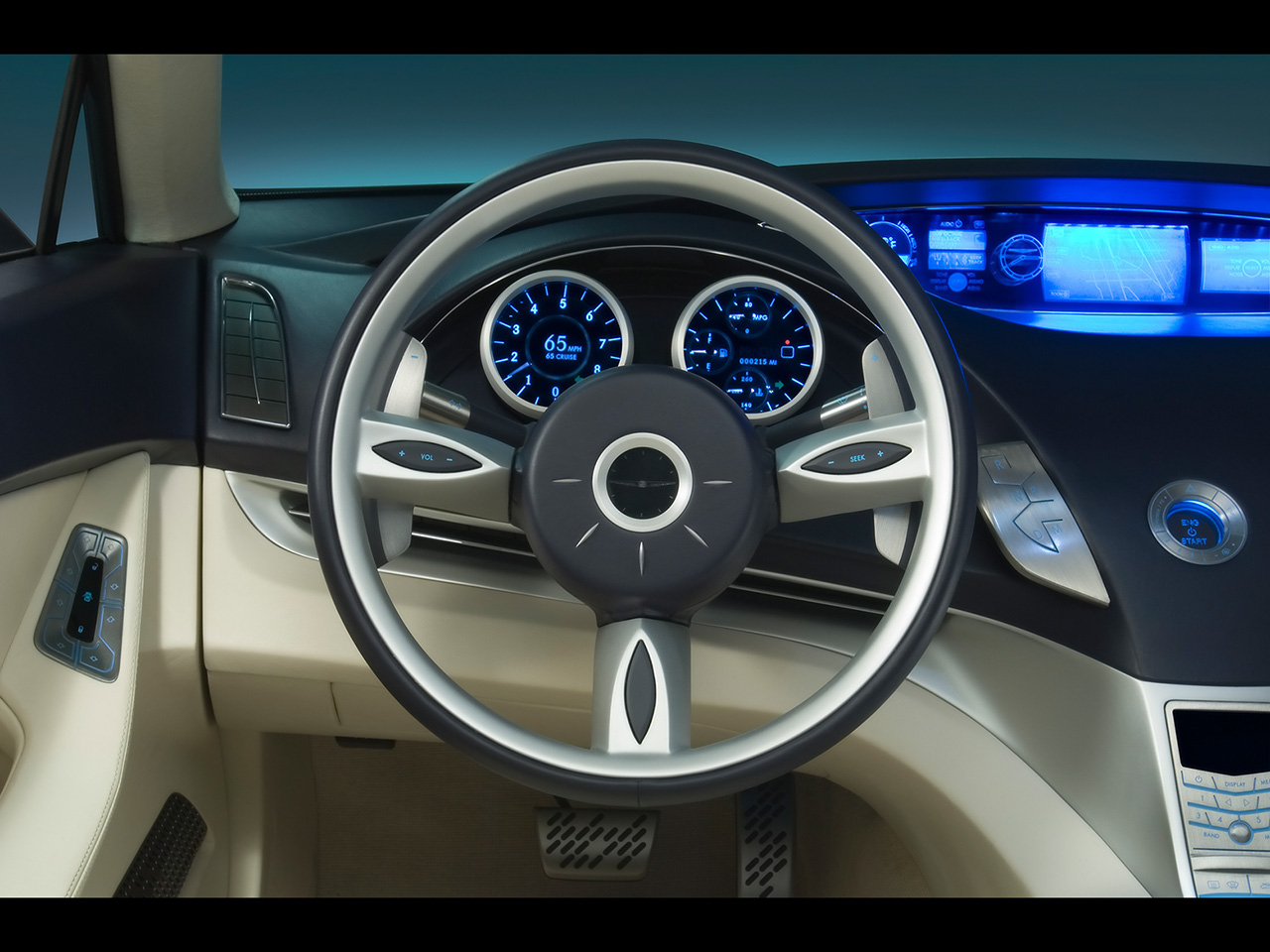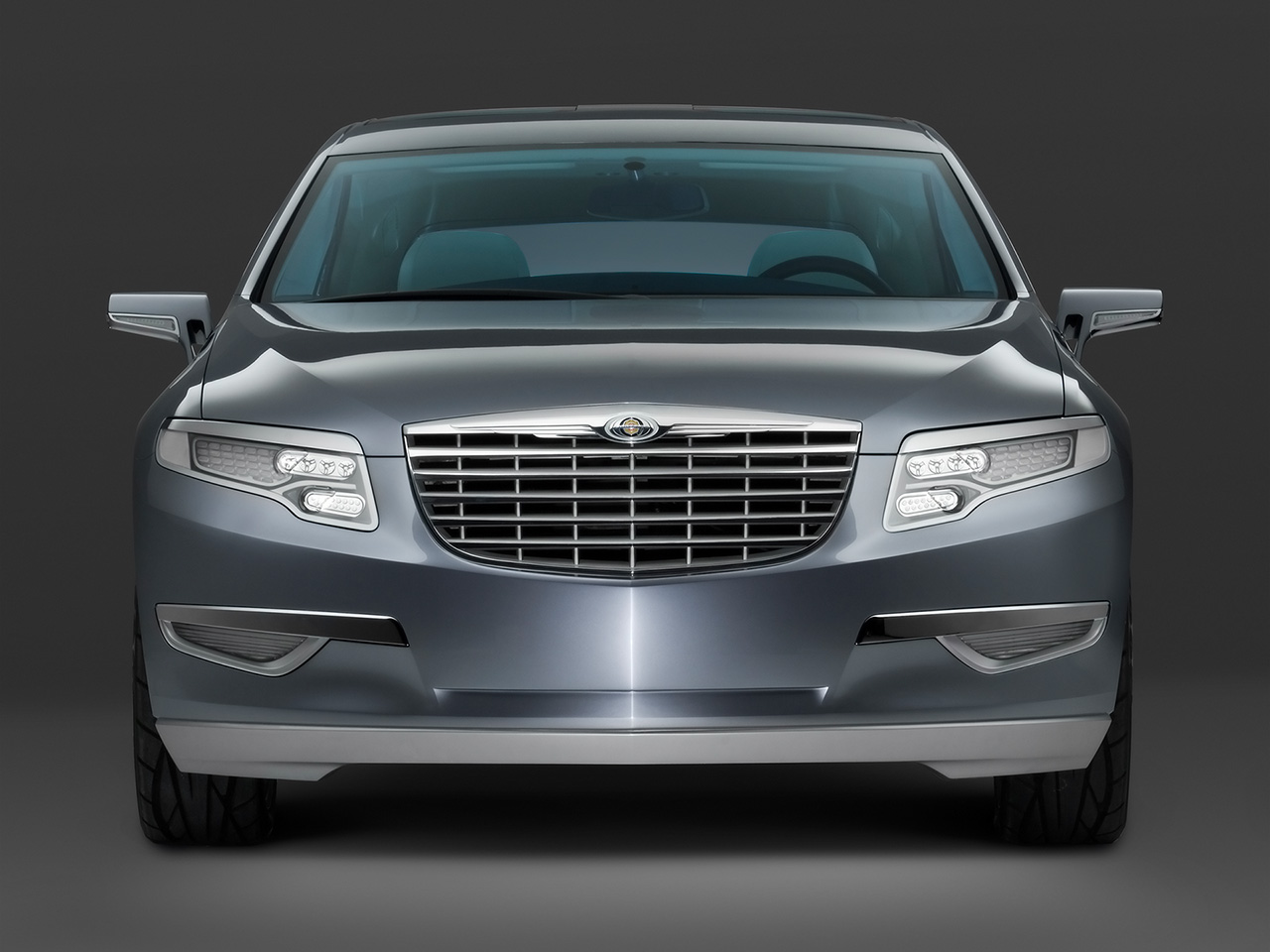2007 Chrysler Nassau Concept
(from DaimlerChrysler
Press Release) Chrysler Nassau Concept: Artistic, Refined Definition
of “What It Is to Be a Chrysler”
Detroit, Jan 8, 2007 - Combining refinement, function and style, the
Chrysler Nassau concept explores a new expression of the Chrysler
brand. The four-door, four-passenger Chrysler Nassau luxury coupe
is, as Alan Barrington, principal exterior designer of the concept
said, “a more emotional and artistic articulation of what it means
to be a Chrysler.
Though built on a full-size 120-inch wheelbase, the Nassau appears
more visually compact than a comparable Chrysler 300C.
“Traditional exterior proportions have been enhanced with a
silhouette that recalls the classic English ‘shooting brake,’” said
Barrington. “This provides SUV-like interior volume with a lower,
more roadworthy physique.”
Barrington said the exterior design vocabulary is fluid and
sophisticated with special attention paid to wheel placement
relative to the body surface for a sleek, toned stance.
“In order to attain a more compact appearance,” explained
Barrington, “the Nassau has deliberately concise front and rear
overhangs, with the body surface wrapped around the large 10-spoke
21-inch wheels.”
Accenting the Mystic Blue Pearl color of the body, the sill and the
lower portions of the front and rear fascias are finished in
Starbright Silver. The lower surface of the body is defined by a
subtle undercut that rises slightly toward the rear wheel.
Though the arc of the roof resembles that of a coupe, the Chrysler
Nassau concept is in fact a four-door hard top with front and rear
side glass that retracts fully, revealing the absence of an
above-the-belt B-pillar. The crisp but fluid A-line that closes
slightly against the rising belt is also of particular note.
“We sought to capture the effect of a classic sculpture — an
artistic approach with a shapely flowing of lines that give the
impression of movement even while standing still,“ Barrington said.
“The line in the profile draws down and into the taillamp, leading
the eye of the observer toward to the dramatic back end which
creates its unexpected ‘shooting brake’ appearance.”
In side view, the upper portion of the rear hatch is steeply raked,
with the back light swept cleanly around to the C-pillars. The lower
portion of the tapering back light glass is pulled emphatically
rearward, a treatment repeated in the near vertical surface of the
lower hatch. The flanking taillamps are graphically the reverse of
the headlamps, with the lenses growing wider as they sweep around to
the side, with the bright accent along the bottom of the lens. Much
of the lens is populated by rows of bright rectangles set in a red
field, the rectangles helping to delineate the surface of the rear
quarters when the lamps are unlit. All exterior lighting is visually
distinctive with the use of atypical textures, colors and LED
technology.
Fronting the long hood is a new interpretation of the eggcrate
Chrysler grille, rendered in chrome and satin aluminum. Bracketing
the grille and sweeping rearward nearly to the wheel openings, the
long, narrowing headlamps and their upper chrome brows combine with
the rising sculptured line of the upper fascia to subliminally evoke
the uplifted wings of the Chrysler badge.
The Chrysler Nassau’s lower fascia is accented by the long chrome
brows of the tapering left and right fog lamps, a detail replicated
in the “repeater lamps” of the slim, door-mounted side view mirrors.
The plan view of the Nassau highlights the dramatic swept-back
curves that define both the front and rear fascias.
Stepping into the Chrysler Nassau, one enters a new world of luxury
specially designed to a younger, aspiring audience. The presiding
interior theme is one of flowing seamless sculpture composed of
leathers and fabrics derived from futuristic architectural
interiors.
“We looked carefully at space efficiency,” said Ben Chang, principal
designer of the Nassau’s luxurious interior. “We pushed the interior
surfaces outboard to increase the space inside while individual
bucket seating provides each of the four occupants personal space.
“The look of various components inside the vehicle was inspired by
the design of contemporary cell phones, computers, iPods and MP3
players,” Chang added. “We paid close attention to the graphics and
finishes of these technologically advanced products, seeking to make
controls in the Nassau’s interior that the driver interfaces with
similar to what you’d find in the office or among personal
electronic devices. We strived to achieve a seamless interface
between your car and the rest of your electronic world.”
The instrument panel is a showcase for new technologies in data
display, personal control interface, and home theater-inspired
entertainment. Gear selection is accomplished via a pod control
mounted on the instrument panel while the steering wheel
incorporates auxiliary paddle shifters.
“The look of the instrument cluster was based on an expensive watch,
again because we sought to create a visible connection with what
people have and use,” Chang said.
While the instrument cluster has its own taut brow, the shape of the
forward portion of the instrument panel is sensuously sculpted.
Housing the main cluster, the upper surface of the panel includes a
wide asymmetrical elliptical opening.
The shape was inspired and reminiscent of Constantin Brancusi’s
famous Bird in Space sculptures. Brancusi, an artist based in Paris
from the 1920s to the 1940s, was preoccupied by physical attributes
of birds in flight, or more specifically, the essence of flight. The
theme fits perfectly with the vehicle’s goal of giving the constant
impression of smooth, slender movement.
Within the housing of the instrument panel (I/P) is a three-layer
screen, which allows the simultaneous display of the navigation,
passenger entertainment and vehicle function displays.
As they move toward the doors, the left and right side lower
portions of the two-tone I/P rise upward, again subtly reprising the
Chrysler wings. Sandwiched between the upper and lower surfaces of
the instrument panel are partially-concealed horizontal vents that
direct cool air into the cabin.
The four handsomely-formed bucket seats are covered in cream-colored
leather, with the suede accents in a fine bamboo texture, a theme
repeated on the door trim panels. Occupants can gaze upward through
twin “Picture View” skylights, longitudinal blue-tinted glass panels
that run the length of the roof panel. Those in the rear seats can
enjoy a movie displayed on the flush video screens incorporated into
the rear-facing portion of each of the front seat headrests.
Running fore-aft between the seats is a center console with a satin
silver trim strip that travels from the I/P center stack to the
upper rear seat backs. Set within the console are the front and rear
“joy stick” controls designed to function much like the “mouse”
control of a home or office computer. Power window switches and
flush-mounted pop-up cup holders are also contained in the console.
Among the more interesting visual details within the Deep Mystic
Blue and Cream interior are the refined-yet-simple chrome accents
and textures used on the silver speaker grilles on the doors, seat
back monitors, headliner and foot pedals.
Behind the passenger cabin, the surface of the boat tail-shaped
cargo cover is accented with five stainless steel accent strips,
while panels in the carpeted cargo area below offer additional
storage.
“With its sculptural artistry and technological sophistication, the
interior of the Chrysler Nassau is the perfect complement to its
visually-arresting exterior,” said Chang.



